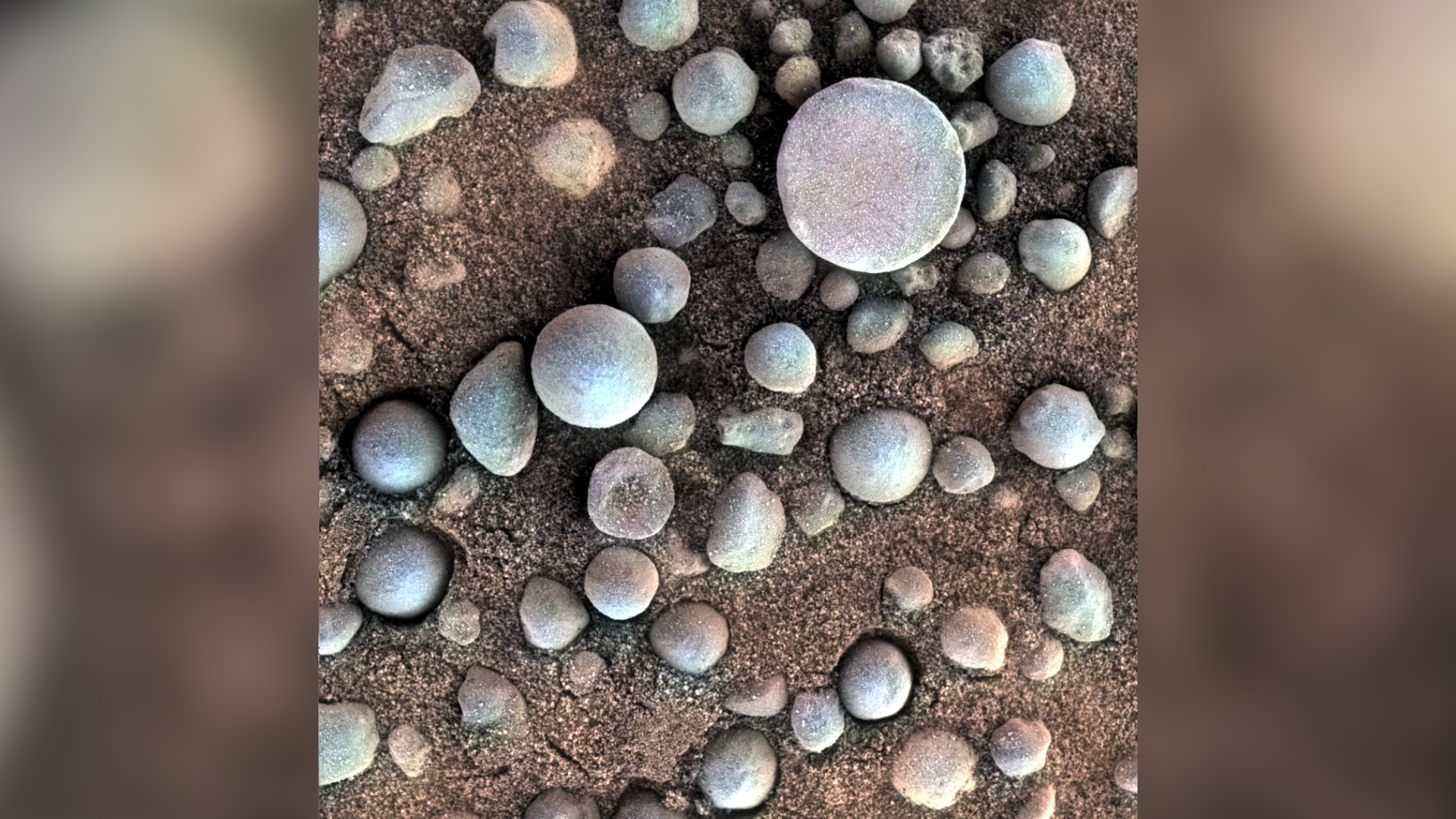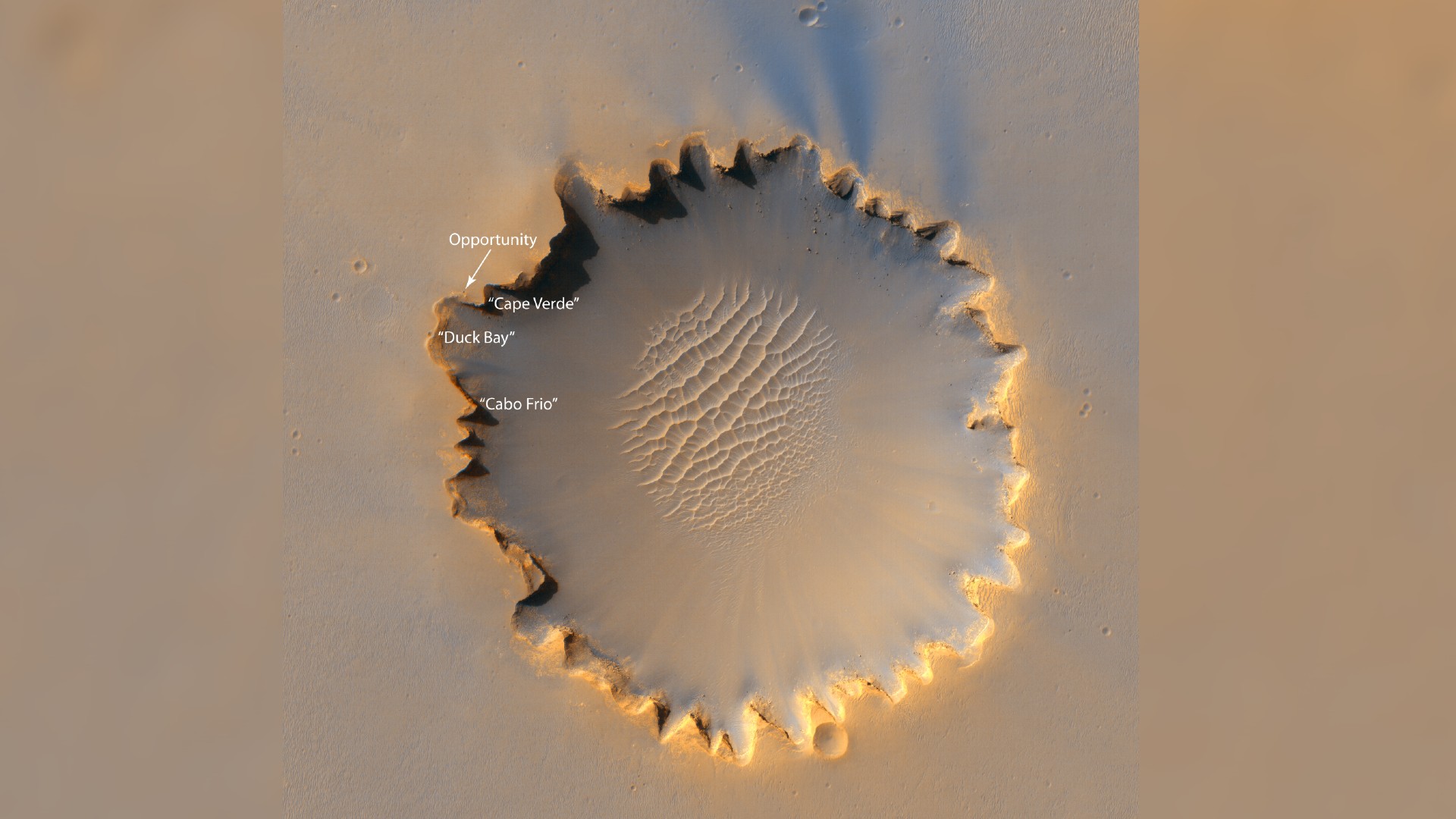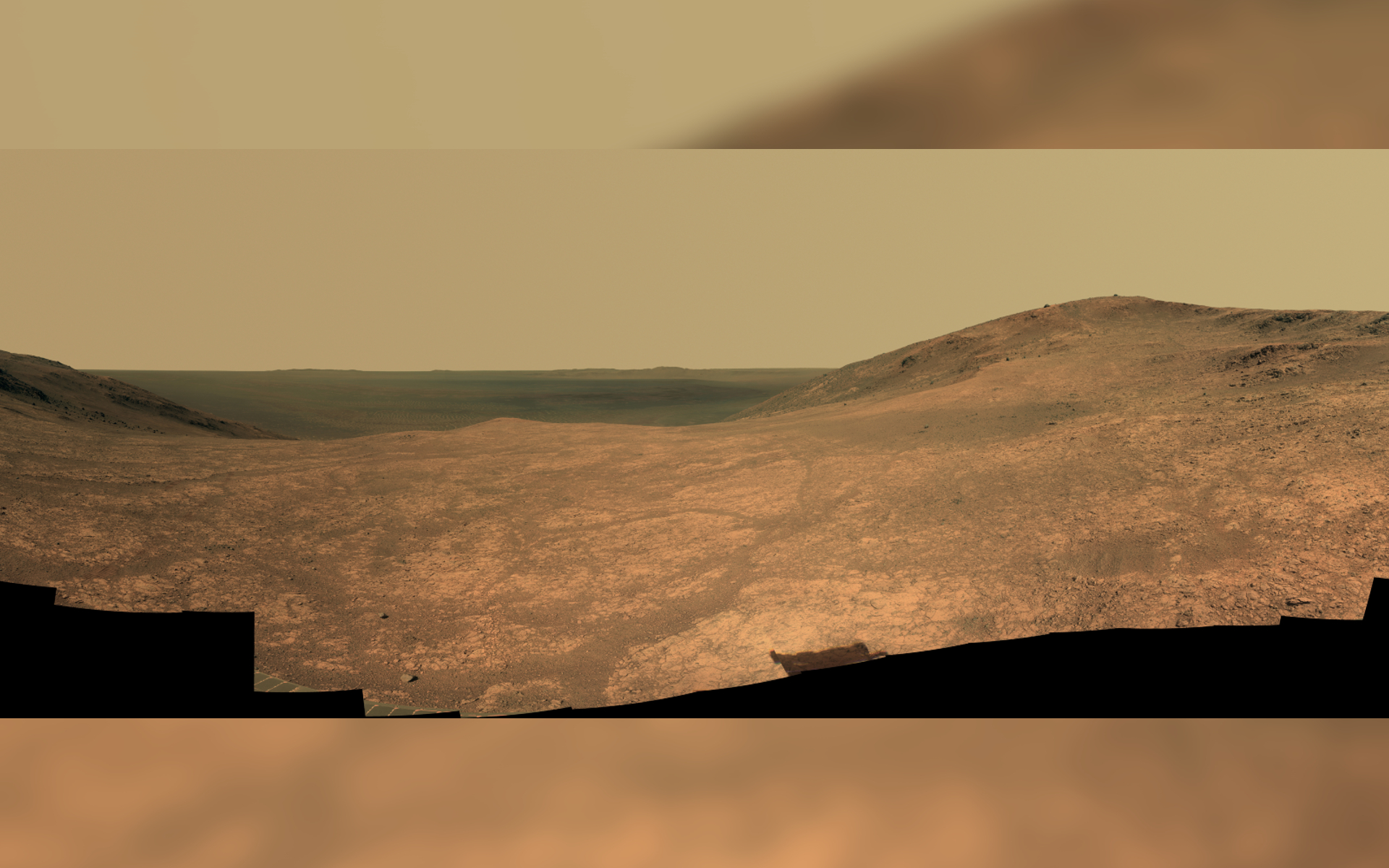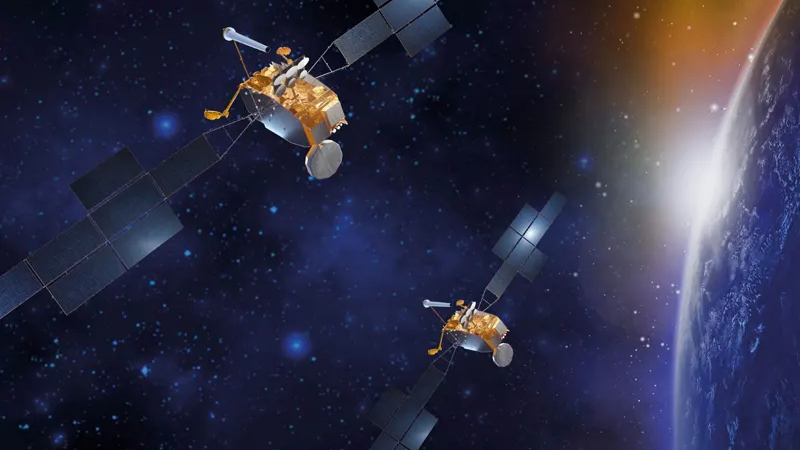Opportunity: Longest-running Mars rover
Opportunity also fondly known as 'Oppy' explored the Red Planet for more than 14 years.
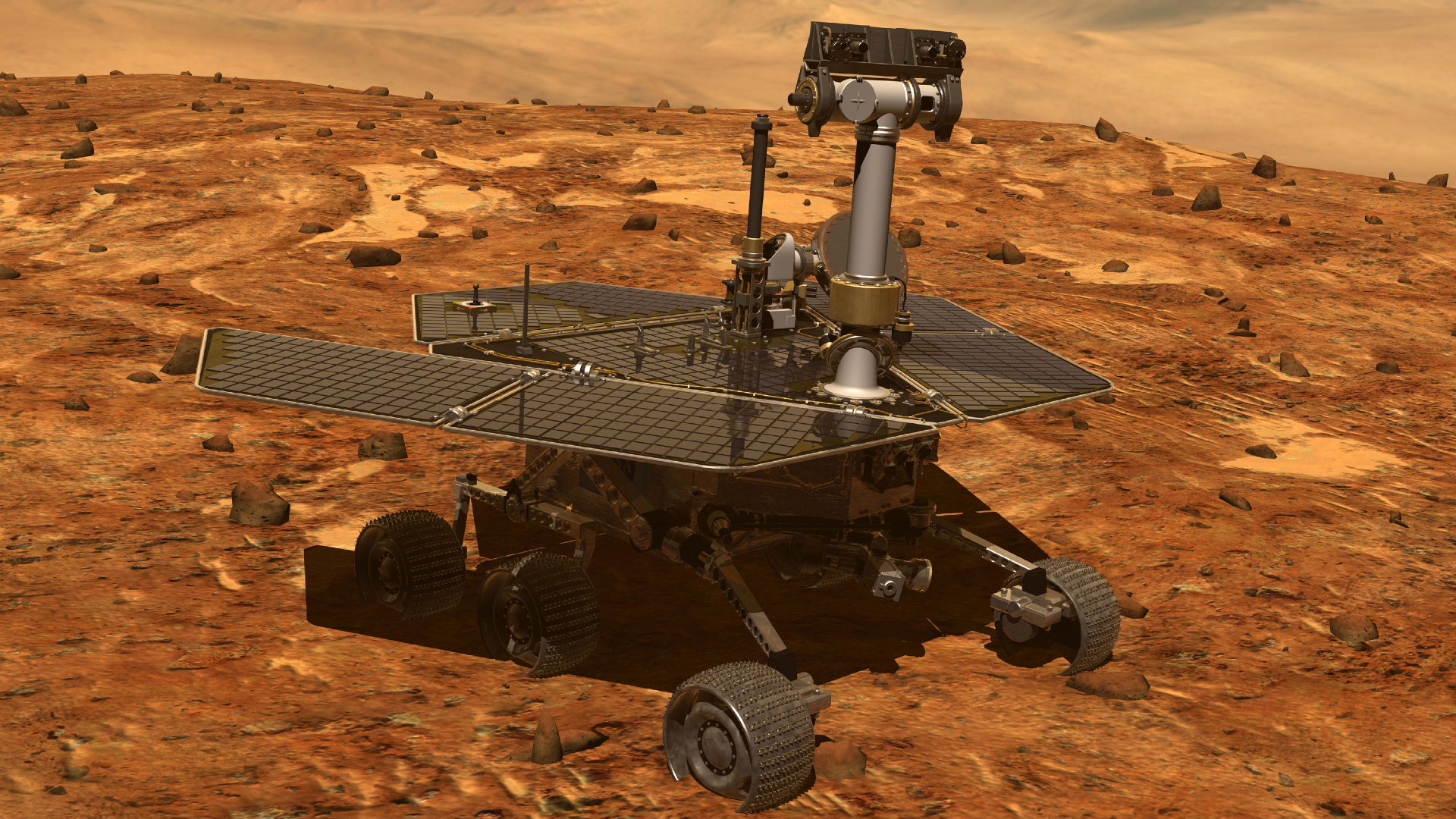
The Opportunity rover worked on Mars from January 2004 through June 2018, when a monster dust storm silenced the golf-cart-size robot for good.
Originally intended to last 90 days, the machine crawled more than the distance of a marathon (26.2 miles, or 42.1 kilometers) during its long and accomplished life. At the time of its death, the rover's odometer read 28.06 miles (45.16 km).
One of Opportunity's greatest scientific findings was confirming the presence of standing water on Mars for long periods. The rover uncovered the presence of hematite, gypsum and other rocks on Mars that tend to form in water on Earth, and also found evidence of ancient hydrothermal systems.
Related: Mars missions: A brief history
Opportunity also demonstrated it was possible to operate a rover for more than a decade on another planet, overcoming engineering and driving issues as it continued to perform scientific work.
Opportunity fell silent when a global dust storm swept across Mars in June 2018. The rover requires solar power for operations, and during heavy dust storms, there are too many particles in the air to allow sunlight to reach Opportunity's solar panels. NASA tried to rouse Opportunity for months but never got a response, and the rover was finally declared dead in February 2019.
Opportunity has generated an immense scientific legacy that will help with the work of NASA's still-active Curiosity rover and the upcoming Mars 2020 rover.
Breaking space news, the latest updates on rocket launches, skywatching events and more!
Mission summary and design
Opportunity and its twin rover, Spirit, were developed as part of NASA's Mars exploration program. NASA has sent many missions to the Red Planet since the 1960s, with some of the prominent missions including Mariner 9 (the first orbiter), Viking 1 and Viking 2 (the first landers) and Sojourner/Pathfinder (the first rover). In the last two decades, NASA has focused on sending a Mars mission as often as possible, which means every two years at the time when Earth and Mars come relatively close to each other in their orbits.
The major goals of the two rovers, according to NASA, were to determine whether life as we know it could ever have arisen on Mars (focusing particularly on searching for ancient water) and to characterize the climate and geology of Mars. The information these rovers collected would be enhanced with observations from orbit — such as those collected by NASA's long-running Mars Reconnaissance Orbiter — and would inform future missions to the Red Planet.
The Mars Exploration Rovers received their names from 9-year-old Sofi Collis, who was the winner of a naming contest NASA held (with assistance from the Planetary Society and sponsorship from toy maker Lego). Siberian-born Collis was adopted at age 2 and moved to live with her new family in Scottsdale, Arizona.
"I used to live in an orphanage," Collis wrote in her winning essay. "It was dark and cold and lonely. At night, I looked up at the sparkly sky and felt better. I dreamed I could fly there. In America, I can make all my dreams come true. Thank you for the 'Spirit' and the 'Opportunity.'"
The Mars Exploration Rovers launched in 2003 — Opportunity on July 7, and Spirit on June 10 — aboard Delta II rockets. They embarked on a 283-million-mile (455.4 million km) journey to hunt for water on Mars. The $800 million cost for the two rovers covered a suite of science instruments, including a panoramic camera, a microscopic imager, engineering cameras, three spectrometers, a rock abrasion tool and a magnet array. The rovers also had a small arm that allowed them to obtain close-up pictures and data from interesting scientific targets.
Early work on Mars
NASA was intrigued by a layer of hematite that the orbiting Mars Global Surveyor spotted from above, located on the Meridiani Planum at the Martian equator, and decided that would be Opportunity's landing site. Because hematite (an iron oxide) often forms in a region that had water, NASA was curious about how the water got there in the first place and where the water went.
The 384-pound rover made its final approach to Mars on Jan. 25, 2004. It plowed through the Martian atmosphere, popped out a parachute and then vaulted to the surface in a cocoon of airbags. Opportunity rolled to a stop inside a shallow crater just 66 feet (20 meters) across, delighting scientists as the first pictures beamed back from the Red Planet.
"We have scored a 300-million-mile interplanetary hole-in-one," Steve Squyres, a planetary scientist at Cornell University and the principal investigator for the rover's science instruments, said in a news release shortly after the landing.
In early March, just six weeks after landing, Opportunity identified a rock outcrop that showed evidence of a liquid past. The rocks at Guadalupe (a region on Mars) had sulfates, according to NASA, as well as crystals that grew inside of niches — both signs of water. Spirit found carbonates and hematite, more evidence of water, that same week. Opportunity also found hematite inside small spheres that NASA dubbed "blueberries" because of their size and shape. With one of its spectrometers, Opportunity found evidence of iron inside a group of blueberries when comparing it to the bare, underlying rock.
Before March was over, Opportunity discovered more evidence of water, this time from images of a rock outcrop that probably formed from a deposit of saltwater in the ancient past. Chlorine and bromine found in the rocks helped solidify the theory.
It was a positive start to Opportunity's mission — and the rover hadn't even left the crater where it had landed. Before Opportunity's 90-day primary mission was over, the golf-cart-size rover had clambered out of Eagle Crater and ventured to its next science target about half a mile away: Endurance Crater. It spotted more water signs there in October 2004.
Stuck in the sand
One of Opportunity's most dangerous moments came in 2005 when the rover was mired in the sand for five weeks. NASA had put the rover into a "blind drive" on April 26, 2005, meaning the rover was not checking for obstacles as it went. Opportunity then plowed into a 12-inch-high (30 centimeters) sand dune, where the six-wheeled rover initially had trouble getting out.
To save the stranded rover, NASA ran tests on a model of the rover in a simulated Martian "sandbox" at the Jet Propulsion Laboratory. Based on what they learned in the sandbox, the rover drivers then sent a series of commands to Opportunity. It took the rover about 629 feet (192 m) of wheel rotations before it was able to move forward 3 feet (1 m), but it eventually pulled itself free in early June 2005, NASA said.
NASA chose to move the rover forward in more careful increments, which was especially important because Opportunity lost the full use of its right-front wheel (because of a jammed steering motor) just days before it got stuck in the sand. The rover could still move around just fine with its other three steerable wheels, NASA said.
Opportunity's experience in the sand came in handy in October 2005, when NASA detected unusual traction problems on Martian solar day, or sol, 603. Just 16 feet into a planned 148-foot drive, a slip-check system on board automatically stopped the rover when it lost traction and went past a programmed limit for the number of wheel turns, according to NASA. Two sols later, Opportunity managed to back itself out and kept on going.
Victoria Crater
In late September 2006, after 21 months on Mars, Opportunity wheeled up to Victoria Crater. It circled the rim for a few months, snapping pictures and getting a close look at the layered rocks surrounding the crater. NASA then made a gutsy decision in June 2007 to take Opportunity inside the crater. It was a risk, as it was unclear if the rover could climb out again, but NASA said the science was worth it.
"The scientific allure is the chance to examine and investigate the compositions and textures of exposed materials in the crater's depths for clues about ancient, wet environments," NASA said in a news release. "As the rover travels farther down the slope, it will be able to examine increasingly older rocks in the exposed walls of the crater."
The trek down was interrupted by a severe dust storm in July 2007. Opportunity's power-generating capabilities dropped by 80 percent in only one week as its solar panels became covered in dust. Late in the month, Opportunity's power dipped to critical levels. NASA worried the rover would stop working, but Opportunity pulled through.
It wasn't until late August that the skies cleared enough for Opportunity to resume work and head into the crater. Opportunity spent about a year wandering through Victoria Crater, getting up-close looks at the layers on the bottom, which scientists thought were likely shaped by water.
Opportunity climbed out successfully in August 2008 and began a gradual journey to Endeavour, a crater located 13 miles (21 km) away. That may not seem far, but it took about three years to get there, as the rover made several stops to look at interesting science targets on the way. Opportunity reached the crater in August 2011. By then, its twin rover, Spirit, had died in a sand trap. (It got stuck in March 2010, and NASA declared the rover defunct in 2011 after the Martian winter passed and the agency had heard nothing from the stranded rover.)
Exploring Endeavour and memory resets
Opportunity's water history examinations continued at Endeavour, with one example being a 2013 probe of a rock called “Esperance.” The rock not only has clay minerals produced by water but there was enough of the liquid to "flush out ions set loose by those reactions," Scott McLennan, a professor at the State University of New York and a long-time planner for Opportunity's science team, said at the time.
In 2014 and early 2015, NASA made several attempts to restore Opportunity's flash-memory capabilities after the rover experienced problems. Flash memory allows the rover to store information even when it is powered off, such in the case of a bad storm. In 2015, NASA decided to continue most operations with random-access memory instead, which keeps data only when the rover's power is on. At the time, NASA said the only change to operations would be requiring Opportunity to send high-priority data right away rather than storing the data for later delivery.
Despite occasional setbacks, Opportunity set an off-world driving record in July 2014 when it successfully passed 25.01 miles (40.2 km), exceeding the distance from the Soviet Union's remote-controlled lunar Lunokhod 2 rover in 1973. In March 2015, it passed another huge milestone: traveling a marathon distance (26.2 miles, or 42.2 km) on Mars.
From its view inside Endeavour, the rover logged images of the comet Siding Spring when the icy object sped by Mars at a distance of 87,000 miles (139,500 km) in October 2014. In January 2015, Opportunity took pictures from a high point on the rim of Endeavour, about 440 feet (134 m) above the plain surrounding the crater. Then, in March 2015, NASA announced that the rover — while overlooking an area nicknamed Marathon Valley — had seen rocks with a composition unlike others studied by Spirit or Opportunity. One of the features of the rocks was high concentrations of aluminum and silicon. This composition was the first time such rocks were found on Mars.
After working through a Martian winter, in March 2016, Opportunity tackled its steepest slope ever — a tilt of 32 degrees — while trying to reach a target on Knudsen Ridge, within the Marathon Valley region. As engineers watched the rover's wheels slip in the sand, they decided to abandon the target and move on.
NASA announced it was wrapping up operations in Marathon Valley in June 2016, and added that Opportunity got a close-up look at "red-toned, crumbly material" on the southern slope of the valley. Opportunity scuffed some of this material with a wheel, revealing some of the highest sulfur content seen on Mars. NASA said the scuffed wheel had evidence of magnesium sulfate, a substance that could have precipitated from water.
2018 dust storm
In late May 2018, a regional dust storm on Mars expanded rapidly. The skies grew dark over Opportunity as the storm reached planetary proportions on June 20. Opportunity, which was in good health at the time and still working at Endeavour, last talked to Earth on June 10, until its solar panels could not pick up enough energy for communications. The rover was expected to stay warm enough through the storm to survive, but scientists and engineers questioned how quickly the weathered rover could be recovered, if at all.
When storms happen on Mars, enormous clouds of dust prevent sunlight from reaching the surface. Higher levels of tau, a measure of atmospheric opacity, indicate that less sunlight is available to Opportunity. The rover requires a tau of less than 2.0 to recharge its batteries. Normally, tau at Opportunity's site is about 0.5, NASA said. Opportunity measured a tau of 10.8 on June 10, 2018, the day it stopped transmitting back to Earth.
NASA continued listening for signals from Opportunity for months through the Deep Space Network — a network of antennas that communicate with spacecraft all over the solar system. No signal was ever received, and Opportunity was finally declared dead in February 2019.
Additional resources
Explore Mars exploration rovers in more detail with these resources from NASA and learn about some of the rovers' most significant discoveries about the Red Planet.

Elizabeth Howell (she/her), Ph.D., was a staff writer in the spaceflight channel between 2022 and 2024 specializing in Canadian space news. She was contributing writer for Space.com for 10 years from 2012 to 2024. Elizabeth's reporting includes multiple exclusives with the White House, leading world coverage about a lost-and-found space tomato on the International Space Station, witnessing five human spaceflight launches on two continents, flying parabolic, working inside a spacesuit, and participating in a simulated Mars mission. Her latest book, "Why Am I Taller?" (ECW Press, 2022) is co-written with astronaut Dave Williams.
